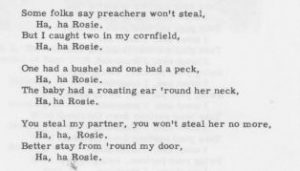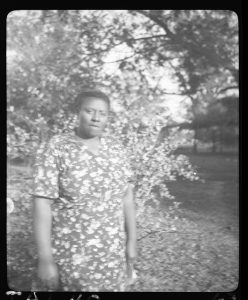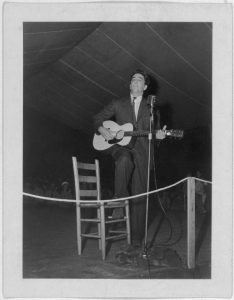Unsure of what to research, even after spending hours scrolling through and skimming journals, narratives, pictures, and musical selections, I inevitably turned to children’s songs on the Library of Congress Lomax Collection. I have always been fascinated by culture and media for children, be it stories, rhymes, or whatever else–I’m even writing a non-fiction book on Nigeria for children right now.
An intriguing aspect of these children’s songs is their folk quality. For example, I dug quite a bit into the song “Rosie.” There are several recordings available in the Lomax Collection and each–despite being recorded within days of each other (May 1939) and in the same area (Livingston, Alabama)–is a little different. These are the versions: Vera Hall, the McDonald Family, and Ed Jones.
This is a classic call and response song, with a leader calling out and the group responding emphatically as a whole. The chorus is essentially the same in each with the “ha ha Rosie” and referring to her as either “baby” or “pretty girl.” The verse lyrics differ, but the overall structure remains the same, as well as the clapping beat underneath. Another recording, from the Smithsonian Folkways Records, is of children at Brown’s Chapel School in Alabama singing the tune:
“Rosie Darling Rosie” appears alongside various other play songs, including ones we may recognize, such as “Mary Mack” and “Loop de Loo.” The lyrics of this one also fall in line with those mentioned above, the chorus following “Rosie darling Rosie / ha ha Rosie / Rosie darling Rosie / ha ha Rosie” and the verses having different words but the same structure. The verse seems to suggest that the song (or at lease this particular rendition of lyric) is from the time of slavery, a slave calling upon his baby to run away with him to Baltimore (a notedly free place in those days) to escape their bondage.

“Rosie Darling Rosie” lyrics from Folkways Records https://media.smithsonianfolkways.org/liner_notes/folkways/FW07004.pdf
The pamphlet that accompanies this record also includes lyrics which the kids do not sing in this particular recording but are still often sung (pictured at right). In the recording of Vera Hall above, she uses these lyrics, except her rendition replaces “preacher” and “two” with “nigger.” Otherwise, it is the same. This illustrates both how folk songs change over time and place and simply who is singing the song, as well as that these folk songs from the days of slavery may be reworked over time to be more palatable to the general populace.

Vera Hall at the home of Mrs. Ruby Pickens Tartt, Livingston, Alabama http://www.loc.gov/pictures/collection/lomax/item/2015645819/
I delved a bit deeper into Vera Hall, as I was most drawn to her rendition of “Rosie.” Apparently, nearly a decade after Alan Lomax recorded her singing in Livingston, AL in 1939, Lomax invited her to come perform at the 1948 Fourth Annual Festival of Contemporary American Music at Columbia University in New York City. She accepted and left Alabama for the first and only time in her life. During this time, she stayed at Lomax’s apartment where he recorded more of her singing (including two more renditions of “Rosie”) and commentaries on the songs and her life. She describes “Rosie” as a song she and the other children in her area would sing and play as a line game. It was a song passed around purely by word of mouth, which is a wonderful example of how folk songs such as this survive.

